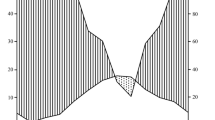Abstract
Microbial biomass, microbial respiration, metabolic quotient (qCO2), Cmic/Corg ratio and nutrient status of the microflora was investigated in different layers of an aspen (Populus tremuloides Michx.) and pine forest (Pinus contorta Loud.) in southwest Alberta, Canada. Changes in these parameters with soil depth were assumed to reflect successional changes in aging litter materials. The microbial nutrient status was investigated by analysing the respiratory response of glucose and nutrient (N and P) supplemented microorganisms. A strong decline in qCO2 with soil depth indicated a more efficient C use by microorganisms in later stages of decay in both forests. Cmic/Corg ratio also declined in the aspen forest with soil depth but in the pine forest it was at a maximum in the mineral soil layer. Microbial nutrient status in aspen leaf litter and pine needle litter indicated N limitation or high N demand, but changes in microbial nutrient status with soil depth differed strongly between both forests. In the aspen forest N deficiency appeared to decline in later stages of decay whereas P deficiency increased. In contrast, in the pine forest microbial growth was restricted mainly by N availability in each of the layers. Analysis of the respiratory response of CNP-supplemented microorganisms indicated that growth ability of microorganisms is related to the fungal-bacterial ratio.
Similar content being viewed by others
References
Adedeji FO (1986) Effect of fertilizer on microbial decomposition of leaf litter on a regeneration bush-fallow in subhumid tropical Nigeria. Agric Ecosyst Environ 18:155–166
Anderson JPE, Domsch KH (1973) Quantification of bacterial and fungal contributions to soil respiration. Arch Mikrobiol 93:113–127
Anderson JPE, Domsch KH (1978) A physiological method for the quantitative measurement of microbial biomass in soil. Soil Biol Biochem 10:215–221
Anderson JPE, Domsch KH (1980) Quantities of plant nutrients in the microbial biomass of selected soils. Soil Sci 130:211–216
Anderson T-H, Domsch KH (1986) Carbon link between microbial biomass and soil organic matter. In: Megusar F, Gantar M (eds) Proceedings of the 4th International Symposium on Microbial Ecology. Ljubljana, Yugoslavia, pp 467–471
Anderson T-H, Domsch KH (1990) Application of ecophysiological quotients (qCO2 and qD) on microbial biomasses from soils of different cropping histories. Soil Biol Biochem 22:251–256
Berg B, Staaf H (1981) Leaching, accumulation and release of nitrogen in decomposing forest litter. Ecol Bull (Stockholm) 33:163–178
Chasseru C (1992) Studies on population dynamics of saprophytic fungi grown on Fagus sylvatica litter, in two forests surrounding Mons (Belgium): Substratum share between species of successional groups. Belg J Bot 125:16–28
Enriquez S, Duarte CM, Sand-Jensen K (1993) Patterns in decomposition rates among photosynthetic organisms: The importance of detritus C:N:P content. Oecologia 94:457–465
Fog K (1988) The effect of added nitrogen on the rate of decomposition of organic matter. Biol Rev 63:433–462
Frankland JC (1981) Mechanisms in fungal succession. In: Wicklow DT, Carroll GC (eds) The fungal community. Its organisation and role in the ecosystem. Marcel Dekker, New York, pp 403–426
French DD (1988) Some effects of changing soil chemistry on decomposition of plant litters and cellulose on a Scottish (UK) moor. Oecologia 75:608–618
Garrett SD (1951) Ecological groups of soil fungi: A survey of substrate relationship. New Phytol 50:149–166
Griffin DM (1985) A comparison of the roles of bacteria and fungi. In: Leadbetter ER, Poindexter JS (eds) Bacteria in nature, vol 1. Bacterial activity in perspective. Plenum, New York, pp 221–225
Hudson HJ (1986) Fungal biology. Cambridge University Press, Cambridge
Jörgensen RG, Meyer B (1990) Nutrient changes in decomposing beech leaf litter assessed using solution flux approach. J Soil Sci 41:279–293
Kendrick WB, Burges A (1962) Biological aspects of the decay of Pinus sylvestris leaf litter. Nova Hedwigia 4:313–342
Lousier JD (1974) Effects of experimental soil moisture fluctuations on turnover rates of Testacea. Soil Biol Biochem 6:19–26
Lousier JD, Parkinson D (1979) Organic matter and chemical element dynamics in an aspen woodland soil. Can J For Res 9:449–463
Maraun M, Scheu S (1995) Influence of beech litter fragmentation and glucose on the microbial biomass in three different litter layers of a beechwood. Biol Fertil Soils 19:155–158
Mandels GR (1965) Kinetics of fungal growth. In: Ainsworth GC, Sussmann AS (eds) The fungi, vol 1. Academic, London, p 599
Parkinson D (1971) Studies on fungi in Canadian aspen forest soil. In: Duvignaud P (ed) Productivity of forest ecosystem. UNESCO, Paris, pp 425–430
Pirt SJ (1975) Principles of microbe and cell cultivation. Blackwell, Oxford
Prescott CP, Corbin JP, Parkinson D (1989) Input, accumulation, and residence times of carbon, nitrogen, and phosphorus in four Rocky Mountain coniferous forests. Can J For Res 19:489–498
Rastin N, Schlechte G, Hüttermann A, Rasenplänter K (1990) Seasonal fluctuations of some biological and biochemical soil factors and their dependence on certain soil factors on the upper and lower slope of a spruce forest. Soil Biol Biochem 22:1049–1061
Scheu S (1987) Microbial activity and nutrient dynamics in earthworm casts (Lumbricidae). Biol Fertil Soils 5:230–234
Scheu S, Parkinson D (in press) Changes in bacterial and fungal biomass C, bacterial and fungal biovolume and ergosterol content after drying, remoistening and incubation of different layers of cool temperate forest soils. Soil Biol Biochem
Visser S, Parkinson D (1975) Fungal succession on aspen poplar leaf litter. Can J Bot 53:1640–1651
Wardle DA (1993) Changes in the microbial biomass and metabolic quotient during leaf litter succession in some New Zealand forest and scrubland ecosystems. Functional Ecol 7:346–355
Author information
Authors and Affiliations
Rights and permissions
About this article
Cite this article
Scheu, S., Parkinson, D. Successional changes in microbial biomass, respiration and nutrient status during litter decomposition in an aspen and pine forest. Biol Fertil Soils 19, 327–332 (1995). https://doi.org/10.1007/BF00336103
Received:
Issue Date:
DOI: https://doi.org/10.1007/BF00336103




